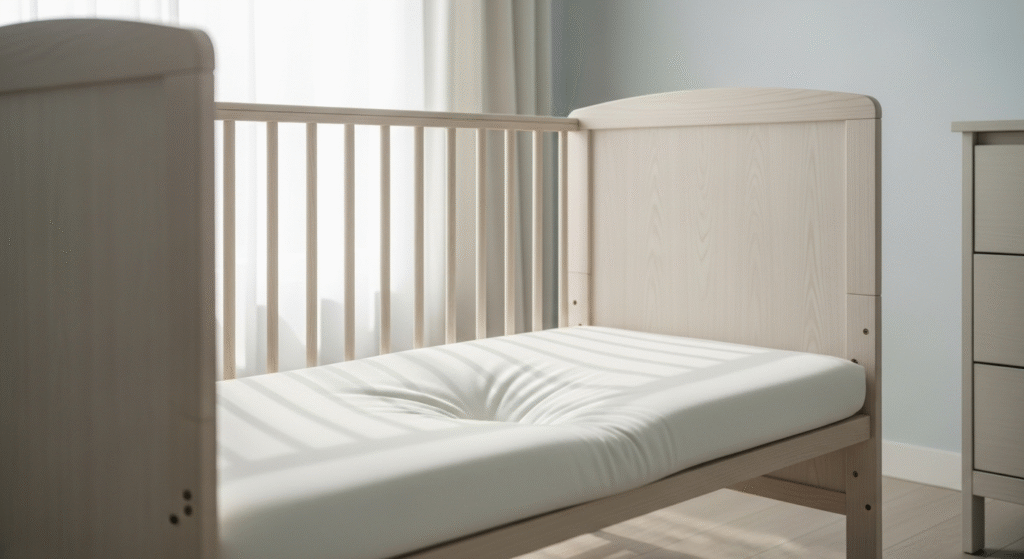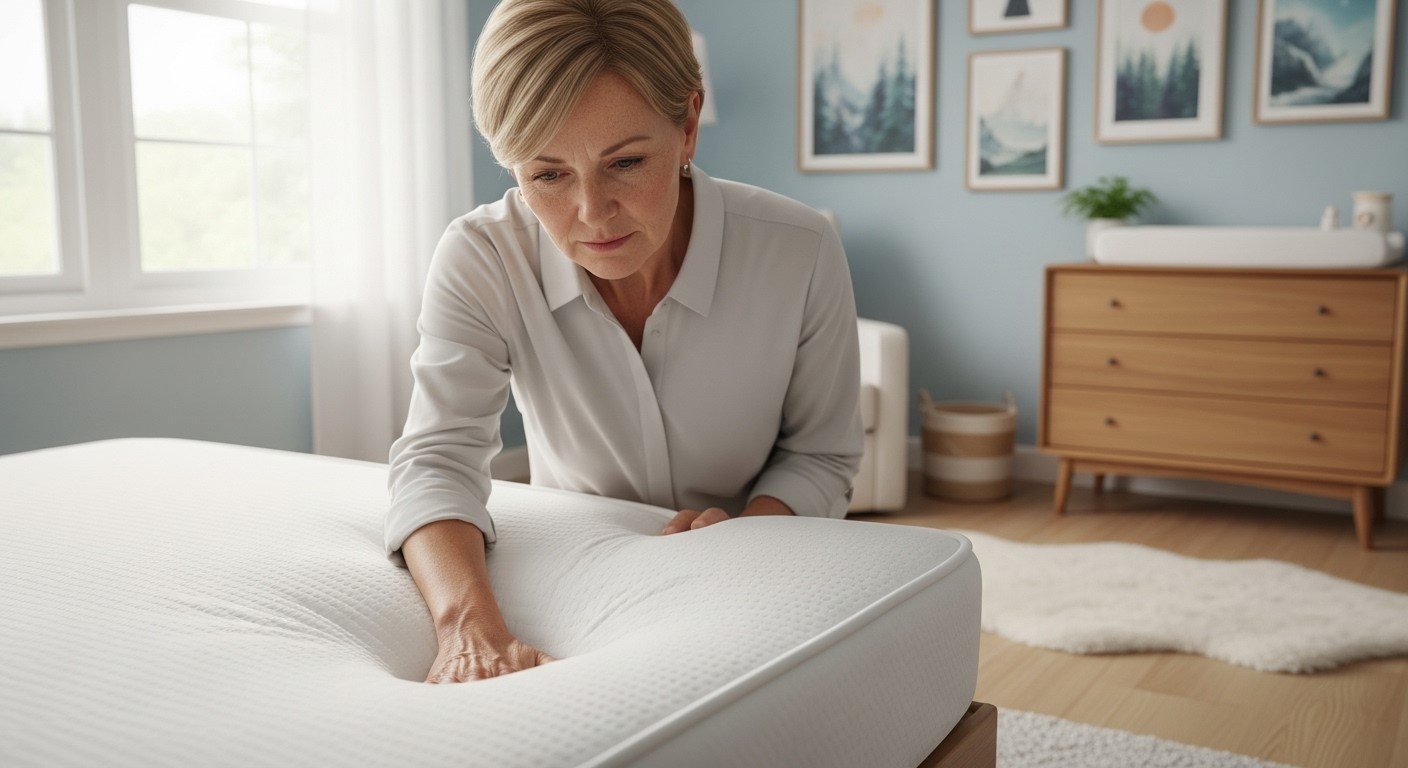Why Is My Crib Mattress Sinking in Middle? A Parent’s Guide to Safety & Solutions
You’re checking on your sleeping baby, and you notice it: a subtle but unmistakable dip.
You might think, “LO’s crib mattress is starting to sink in the middle,” and an immediate wave of anxiety hits.
It doesn’t matter if my baby is 4 months and only 13 lbs; you can see that my baby’s crib mattress starting sagging, and you’re worried.
Your concern is completely valid. You might even have seen discussions on forums like Reddit or Babycenter about this exact issue.
When it comes to your baby’s sleep environment, you can never be too careful. This guide is here to provide clear answers.
We will explain exactly why crib mattresses sink, the real safety risks involved, and what your next steps should be to ensure a safe night’s sleep.
The Safety-First Answer: Why a Sagging Crib Mattress is Dangerous
Let’s address the most important question first: A sagging or indented crib mattress is not safe.
An adult might dream of a mattress that felt cushiony to sink into every evening.
For an infant, however, this type of surface is a serious hazard. A soft surface that is perfect for sinking into is the opposite of what a baby needs.
Major health organizations, including the American Academy of Pediatrics (AAP), emphasize that the single most effective way to reduce the risk of Sudden Infant Death Syndrome (SIDS) and accidental suffocation is to place a baby on their back on a firm, flat sleep surface.
A mattress sagging in the middle compromises this essential safety standard.
- Increased Suffocation Risk: A dip can cause an infant to roll into a position from which they can’t easily move, potentially pressing their face into the mattress and obstructing their airway.
- Unsafe Positioning: The sagging creates an uneven surface that can interfere with a baby’s ability to maintain a safe back-sleeping position.
The official recommendation is non-negotiable. A firm, flat surface is crucial for safe sleep, every single time.

The 5 Main Reasons Your Crib Mattress is Sinking
Understanding why a mattress fails can help you prevent it in the future. Here are the most common culprits behind a sinking sagging cot or crib mattress:
1. Low-Quality Materials & Construction
The core of the mattress determines its durability. Low-density foam is prone to developing indentations.
High-density foam or innerspring mattresses with strong steel frames are more resilient.
2. Improper Foundation
The Improper Foundation underneath the mattress is just as critical. If the crib’s support slats are weak or too far apart, the mattress won’t have a stable base.
In a worst-case scenario where your bed frame is collapsing or bent, this can cause the mattress to sag where it lacks support. This can also lead to sagging on one side.
3. Normal Wear and Tear Over Time
Even well-made mattresses don’t last forever. Most are designed to last three to five years. Over time, materials naturally break down from repeated pressure.
4. Moisture and Liquid Damage
If your crib mattress isn’t protected by a waterproof cover, moisture from accidents can degrade the core materials, leading to permanent sagging.
5. Improper Storage Between Uses
Storing a mattress on its side or in a damp area can cause the internal structure to deform, resulting in a permanent sag.
The “Firmness Test”: How to Know for Sure if Your Mattress is Unsafe
Don’t just rely on a visual check. Use this guide to compare the firmness levels of each mattress and determine if yours is safe.
- Place the mattress on the floor. This lets you test the mattress itself without interference from the crib frame.
- Press firmly on the center and then along the edges with your palm.
- Observe the response. A safe, firm mattress snaps back immediately. If a noticeable indentation remains for more than a few seconds, the mattress has failed the test and is no longer safe.
Common Mistakes & Pro Tips for Parents
Navigating this issue can be stressful. Here are some common mistakes to avoid and pro tips to ensure a safe sleep setup.
- Mistake #1: Searching for a “Sagging Fix”. You may see dangerous DIY ideas online for a sagging fix, like trying to increase mattress thickness with toppers or boards. These “fixes” are extremely dangerous as they can create an unstable surface and introduce new suffocation risks. The only safe fix for a sagging mattress is a replacement.
- Mistake #2: Ignoring a Hand-Me-Down’s History. Always rigorously test a used mattress. If it shows any signs of being one of the new sinks or indentations, do not use it.
- Pro Tip #1: Rotate and Flip to Prevent Sagging. To promote even wear, you should be rotating the mattress 180 degrees or flipping it every few months. Some guides say to try flipping your mattress over and reverse direction. This practice is the key to longevity.
- Pro Tip #2: Always Use a Waterproof Cover. This is the best defense against liquid damage that breaks down mattress materials from the inside out.
- Pro Tip #3: Choose the Right Thickness. Be aware that mattresses that are too thick pose a suffocation risk to infants by reducing the effective depth of the crib. Stick to standard-sized crib mattresses (no more than 6 inches thick) that fit snugly.
Frequently Asked Questions (FAQ)
How long should a crib mattress last?
Most last 3-5 years. However, you must replace any mattress that shows signs of sagging, regardless of its age.
Is a small indentation from my baby’s head normal?
No. A truly firm surface should not hold an impression. If the middle of the mattress is sagging even slightly when your baby isn’t on it, it’s too soft.
Should I adjust my crib mattress height?
Yes, but this is for developmental safety, not to fix a sag. Many parents want to learn how to raise crib mattresses for newborns and toddlers in 5 easy steps, but the key is knowing when to lower it. You must lower the crib mattress when your little one starts sitting independently. When they can pull themselves to a standing position, you need to adjust the crib mattress to the lowest position to prevent them from climbing out. Always lower the crib mattress down to its lowest setting once your baby is mobile.
Can I use a crib mattress board for extra support?
No. This does not fix the core problem, which is an unsafe sleep surface, and can create other hazards.
Conclusion: Trust Your Instincts and Prioritize a Safe Sleep Surface
Discovering that your crib mattress is sinking is concerning, but it’s a solvable problem.
Remember, a sagging mattress is more than a defect; it’s a critical safety hazard.
Your immediate next step is clear: perform the “Firmness Test.” If your mattress fails, do not let your baby sleep on it again.
Trust your instincts and invest in a new, certified-safe mattress that provides the firm, flat surface your baby needs for the safest sleep possible.

